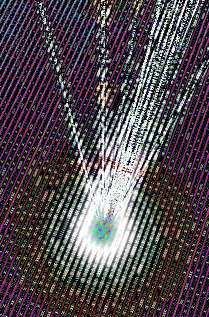Entanglement record set
 Chinese researchers have used quantum entanglement to send an encrypted message further than ever before.
Chinese researchers have used quantum entanglement to send an encrypted message further than ever before.
Entanglement is a key concept in quantum computing; simply put, when two particles are entangled, they become perfectly correlated with each other, no matter how far apart they are. If you could flick one entangled atom, its counterpart would wobble at the same time, even if it was on the other side of the universe.
The quantum phenomenon has now been used to exchange a ‘secret key’ for encrypting and decrypting messages over a distance of 1,120 kilometres, using a satellite and two ground stations.
This type of entanglement-based quantum key distribution should be a big boost to encrypted communications, as it is theoretically very secure.
Previous attempts to directly distribute quantum keys between two ground users under real-world conditions have reached distances of only around 100 kilometres. One lab was able to demonstrated quantum key distribution along up to 404 kilometres of coiled optical fibre in a laboratory, or from a satellite to a ground station up to 1,200 kilometres away.
However, real-world application between two users has been limited to around 100 kilometres. This is due to photon losses, which increase rapidly with distance. In previous attempts, trusted relays or ‘repeaters’ have been used to extend the distance and avoid photon loss, but the relay stations introduce security risks.
But now, researchers at the University of Science and Technology of China have circumvented the need for repeaters by using a satellite to establish a secure link between two ground stations on Earth, using entangled photons.
Two telescopes, designed to receive such quantum signals, were built 1,120 kilometres apart in Delingha and Nanshan in China.
Entangled photons produced by the Micius satellite were transmitted to the ground as the satellite passed over the stations.
Although satellite-based entanglement distribution has been reported before, the authors have now increased their transmission efficiency and reduced error rates enough to use entanglement to transmit quantum keys. They show that the system produces a secure channel that is resistant to attacks.
The results represent a path towards entanglement-based global quantum networks, the authors conclude.








 Print
Print